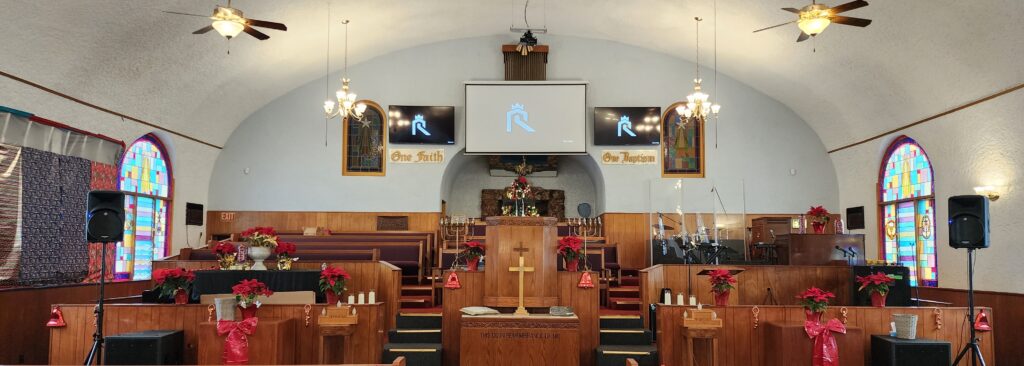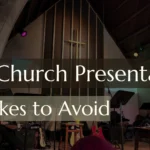How to Do a Presentation in Church
Elen Karapetyan
Posted on November 25, 2024

How to do a Presentation in Church:
A Complete Guide to Creating Impactful Church Presentations
Church presentations are needed for Bible studies, modern worship services, or ministry updates. They allow you to convey God’s word, share inspiring messages, and connect meaningfully with your congregation. Church presentation software can elevate your congregation, ensuring it is engaging, visually appealing, and easy for your audience to follow.
This guide will help you to create a professional, spiritually uplifting presentation for your church.
Top Tips for Effective Slide Usage in Worship
Define the Purpose of Your Church Presentation
Creating a church presentation starts with a clear understanding of its purpose. Knowing the goal of your presentation will guide its content, structure, and design, ensuring it resonates with your audience and supports the message you want to convey.
Before diving into the technical aspects, clearly define your presentation’s purpose. Are you:
Sharing a sermon?
Leading a worship service?
Presenting a ministry update or upcoming event?
Identifying your purpose will help you structure your content, select the right visuals, and effectively engage your audience.
Pro Tip: Align your presentation with the church’s theme or sermon series.
Plan and Organize Your Content
Effective church presentations start with thoughtful planning and clear organization. Organizing your content helps deliver a message that is clear, engaging, and spiritually meaningful for your audience. Here’s how to effectively plan and organize your presentation:
1. Define Your Key Message
- Choose the primary message you want to convey.
- Focus on one or two key points to make your message clear and easy to remember.
2. Create an Outline
- Break your presentation into sections, such as an introduction, main points, and conclusion.
- Arrange your content logically to guide your audience through your message.
For example:
- Introduction: Open with scripture, a question, or a story.
- Main Points: Share teachings, examples, or testimonials.
- Conclusion: End with a call to reflection, prayer, or action.
3. Incorporate Visual and Scriptural Support
- Use Bible verses, images, or short videos to strengthen your message.
- Keep your slides clean and simple by focusing on key phrases instead of overloading them with text.
4. Align Content with Church Goals
- Ensure your content aligns with the sermon series, worship theme, or the church’s mission.
- If applicable, include announcements or ministry updates as part of your presentation.
5. Tailor to Your Audience
- Consider the age group and interests of your congregation.
- Use language and visuals that connect with your audience while staying true to your message.
Effective planning and organization make your church presentation more impactful, creating a meaningful experience that helps your audience connect with the message on a deeper level.
Select the Best Backgrounds for Your Slides
Choosing the right background for your slides is crucial in creating a visually appealing and effective church presentation. The background establishes the tone of your message and directs the audience’s attention. Here are some helpful tips for choosing the best backgrounds:
1. Keep It Simple
- Avoid overly complex or busy backgrounds that can distract from your content.
- Choose simple, clean designs that improve readability and emphasize key points.
2. Align with the Theme
- Choose backgrounds that match the theme of the service, sermon, or event.
- For example, a peaceful nature scene might work well for a sermon on creation, while a minimalist design may be more appropriate for a reflective service.
3. Ensure Good Contrast
- Make sure the text on your slides stands out clearly from the background.
- Use contrasting colors, such as light text on dark backgrounds or dark text on light backgrounds, to ensure readability from any distance.
4. Use Visual Consistency
- Use a consistent background style throughout your presentation to maintain a cohesive look.
- This keeps the focus on your message instead of distracting the audience with different slide designs.
5. Avoid Overuse of Graphics or Images
- While images can enhance your message, too many can overwhelm the audience.
- Choose one or two relevant images per presentation, ensuring they support and strengthen your key points.
6. Consider Accessibility
- Make sure your backgrounds are accessible for all viewers, including those with visual impairments.
- High-contrast designs and clear fonts are essential for making your presentation inclusive.
By selecting the right backgrounds, you can create a presentation that enhances your message, captures your audience’s attention, and helps them stay engaged throughout the service.
Create Visually Appealing Slides
Your slides should support your message without distracting the congregation.
Design Tips:
Use large fonts (e.g., 28–36pt) for scriptures and lyrics.
Stick to a clean, minimalist design with complementary colors.
Include high-quality images that match your message.
Avoid Overloading Slides:
Limit each slide to 2-3 key points or a Bible verse.
Use transitions sparingly to maintain focus on the message.
Practice Your Delivery
Rehearsing is essential for building confidence and ensuring a smooth presentation.
Familiarize Yourself: Spend time navigating the presentation software.
Check Equipment: In advance, test microphones, projectors, and other AV tools.
Engage with the Audience: Use a conversational tone, make eye contact, and invite participation through prayer or discussion.
Enhance Worship with Interactive Elements
Incorporating interactive elements can deepen engagement:
Congregational Singing: Display worship lyrics synced with the music.
Responsive Readings: Use slides for call-and-response scriptures.
Announcements: Showcase upcoming events with eye-catching visuals.
Evaluate and Improve
After your presentation, seek feedback from church members and leaders:
Were the visuals and slides clear?
Did the congregation connect with the message?
Were there any technical challenges?
Use this feedback to refine future presentations.
Conclusion: Creating Impactful Church Presentations: Final Tips for Success
Creating a powerful and engaging church presentation requires a blend of thoughtful planning, effective use of visuals, and practice. By focusing on the purpose of your presentation, organizing your content, selecting the right backgrounds and slides, and rehearsing your delivery, you can ensure your message resonates with your congregation. Church presentation software can elevate your experience, making connecting spiritually with your audience easier.
Remember, the goal is to present information and create an immersive, meaningful experience that supports your message and helps your congregation grow spiritually.
Question:
What elements have you found most helpful in creating impactful presentations for your church?



